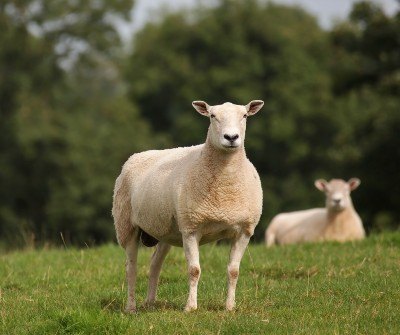Ram Fertility and Tupping
Targets
The target for ram performance is >90% of ewes pregnant after the first breeding cycle. The most common cause of poor conception rates is due to a sub-fertile ram rather than infectious disease.
Ram management
Effective management of rams requires year-round attention – it’s easy to forget about the rams’ care.
- Make sure to give them their vaccinations (particularly clostridial vaccines), worming/fluke treatments as necessary, routine footcare etc.
- Shear and provide shade to prevent heat stress in summer. When shearing, carefully trim excess wool from scrotum to reduce the risk of the testes overheating.
- Keep rams healthy and stress-free for ten weeks prior to tupping. Sperm production takes seven weeks, and you do not want any health issue or stress factor detrimentally affecting this.

- Feeding some bypass protein in the 8 weeks pre-tupping can boost testicle size. Beware of overfeeding the rams, as this can have a detrimental effect on sperm production.
- Rams should have a body condition score (BCS) of 3.5-4.0 out of 5.0 at tupping. It is recommended to give supplementary feeding ~0.7kg concentrates daily during the mating period to minimise condition loss. It is an important part of post-tupping care to get a ram’s BCS back to 3.0.
- Mineral supplements – Zinc and Selenium are required for good fertility and supplementation may boost performance even where there is no deficiency.
- Culling aged rams is recommended after 5-6 years of age, as older rams are likely to struggle to achieve good conception rates.
Replacement rams
Purchase replacement rams at least four weeks before use and put into quarantine.
Many purchased rams will have been fed on a high concentrate diet before sale, so it is important to get the ram’s digestive system used to grazing before he goes out with the ewes. If you do not, they can melt away when they start to work. It takes at least 2 weeks for the digestive system to adapt to a change in diet.
Give quarantine treatments and test for infectious diseases as recommended by your vet. Introduce the ram to the group carefully to try and minimise fighting.
Breeding soundness examination (BSE) and semen testing
All rams > 6 months of age should have a physical MOT and be fertility tested 6-8 weeks before tupping. It has been demonstrated that around 20% of rams have sub-optimal fertility at BSE.
- Testes size and mobility – scrotal circumference >30cm (6-14mths) / >33cm (mature rams) and testes of equal size. Testicles should be freely mobile within the scrotum, firmness like a flexed bicep, with uniform consistency. Epididymis – firm. Cords – no lesions.
- Scrotum, Prepuce, Vermiform appendage – no lesions.
- Brisket – no lesions.
- Teeth – not broken mouthed, incisors aligning with dental pad, no missing molars.
- Legs/Feet – good conformation, no lameness.
- Eyes – clear with no discharge.
These tests will detect ~50% of sub-fertile rams. Semen testing is required to detect the other 50%.
Semen can be collected on farm by your vet using electroejaculation. The vet can then assess the sperm motility on farm and assess the sperm morphology back at the office as the final part of the examination.
Teaser Rams
Teaser rams – should also be fit and healthy just like the rams, but not fertile! Introduce them two weeks before the rams go in to tighten the lambing pattern. For the teaser effect to work the teasers and the rams should be kept at least a mile away from the ewes for a several weeks before use (out of sight, smell, and hearing). New teasers should be vasectomised 8 weeks before you want to use them.
Tupping
Rams should run with the ewes for a minimum of 34 days (2x 17-day cycles).
Change raddle/brisket paint colour every 17 days. Start with lighter colours and go darker. A significant number of repeats indicates subfertility in one of the rams. If using a raddle check that the harness has been well maintained so that it does not cause brisket sores.
The ewe:ram ratio would usually be 40:1 in a lowland flock, and a maximum of 30:1 if teasers are used. For ram lambs the ratio would usually be 20-30:1 depending on age, breed, genetics and nutrition.
If using more than one ram per group (usually necessary in large flocks) it can be difficult to detect a sub-fertile or male-oriented ram. An older ram usually dominates a younger ram and may prevent it from breeding. If this dominant ram is sub-fertile this will lead to poor conception rates and an increased empty rate.
Article written by Andrew Richmond BVM&S MRCVS, Westpoint Horsham
- 1st July 2021
